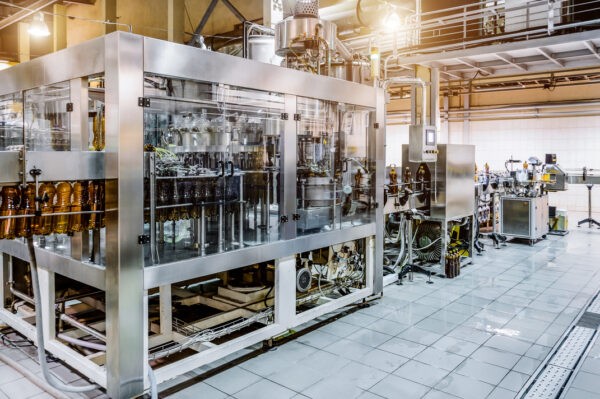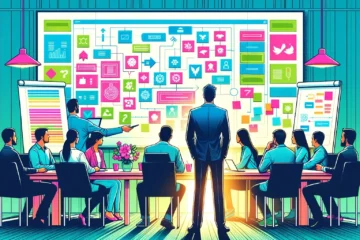In the last few decades, companies have been grappling with the challenges of globalization and localization in the wake of the tumultuous security and political climate. A primary hurdle among them is the increasing need to relocate their manufacturing capabilities to secure jurisdictions. In this way, the implementation of enterprise mobility solutions is increasing demand.
This shift towards localization is not solely motivated by the political instability and risks associated with Russia’s aggression in Ukraine but also by economic factors. In this blog, we will explore the evolution of manufacturing logistics, from globalization to localization, examining the role of digitalization and specific technologies, like blockchain, IoT, and AR, in this evolution.
The Evolution of Manufacturing Logistics
With the current unrest in the security and political landscape, businesses face new challenges that must be addressed. One of these challenges is the increasing demand for relocating manufacturing capacity to safer jurisdictions. Economic reasons also contribute to this trend besides political uncertainty and risks like Russian aggression in Ukraine.
In the 1990s, many companies were looking for ways to maintain their competitiveness in the global market, and some corporations adopted global strategies. These strategies aimed to reduce production costs while taking advantage of operating on a larger, worldwide scale. The integration of these global strategies became a defining factor in reshaping the business landscape during the latter half of the 20th century.

Recent years have seen significant increases in risks associated with some business strategies, such as rising oil prices, natural disasters, and the 2008 financial crisis. As a result, companies have been compelled to alter their tactics and invest more in local production. This can help mitigate the risks associated with dependence on external factors, leading to more stable and sustainable operations.
By concentrating on local production, companies can better manage their supply chain, control costs, and ensure they can deliver high-quality goods and services to their customers despite unforeseen challenges. Moreover, investing in local production can have positive effects on the broader community, creating job opportunities and fostering economic growth in the region.
“The COVID-19 pandemic and the trade war between China and the US have highlighted the need for adaptable and resilient localized sourcing strategies. Companies seeking to stay competitive in the changed economic reality must reduce their reliance on outsourced supply chains by building agile and efficient sourcing networks. Although localization comes with its own challenges, it also provides an opportunity to strengthen relationships with suppliers, reduce lead times, and improve the quality of products. As we navigate the post-pandemic world, businesses prioritizing localization must invest in enterprise mobility solutions that drive flexibility and reduce operational costs.” – said Oleksandr Trofimov, Chief Technology Officer at Artelogic.
The Pros and Cons of Globalization and Localization
Globalization has its advantages and disadvantages. On the bright side, it provides access to cheaper labor and local R&D centers. Additionally, it allows companies to distribute their supply chain risks across multiple regions, which can be beneficial in unexpected events like natural disasters or political unrest.
However, there are also some drawbacks to globalization. It can be challenging to handle the various regulations and systems in different countries and face intellectual property issues. Furthermore, cultural differences can arise, leading to miscommunication or conflicts. Additionally, political risks such as sanctions can also impact globalization efforts.
One example of the advantages of globalization is the manufacturing industry in China. Many companies from around the world have set up factories in China to take advantage of the country’s lower labor costs, which ultimately leads to lower production costs. For instance, Apple Inc. produces most of its iPhones in China to take advantage of cheaper labor costs. Additionally, many companies establish their research and development (R&D) centers in countries where the cost of research is lower, such as India and China, to take advantage of the local talent and knowledge.
On the other hand, a real-life example of the drawbacks of globalization is the intellectual property issue faced by many multinational companies. In 2018, the US imposed tariffs on Chinese goods due to allegations of intellectual property theft by Chinese companies. Many Chinese companies were accused of stealing trade secrets and technology from US firms, which is a significant challenge for companies operating in countries with weak intellectual property laws. Additionally, companies face different regulations and standards in different countries, which can be challenging to navigate, leading to increased compliance costs.
By operating locally, companies can benefit from a more unified culture, which can enhance relationships with customers and employees. Additionally, local regulations can be simpler to understand and manage, and keeping track of the company’s activities can be more manageable. Furthermore, companies often have a greater sense of social responsibility when closely involved with their local communities. Nevertheless, there are also some disadvantages to localization. Hiring a local workforce can be more expensive, which can cut into profits. Additionally, managing logistics and supply chains when delivering products or services globally can be more complicated and costly.
“Although localization comes with its own challenges, it also provides an opportunity to strengthen relationships with suppliers, reduce lead times, and improve the quality of products. As we navigate the post-pandemic world, businesses prioritizing localization must invest in enterprise mobility solutions that drive flexibility and reduce operational costs.”
Oleksandr Trofimov, CTO at Artelogic
An example of localization in logistics can be seen in the operations of McDonald’s in different countries. While McDonald’s is a global brand, it adapts its menus and marketing strategies to suit its regions’ local tastes and preferences. For instance, McDonald’s offers vegetarian options like the McAloo Tikki burger in India. In Japan, McDonald’s offers items like Teriyaki Burgers and Green Tea McFlurry, which cater to Japanese taste buds.
By localizing their menus, McDonald’s can appeal to the specific tastes of their customers, enhance their relationships with the local communities, and adhere to local regulations. However, this also means that McDonald’s must manage their logistics and supply chain differently in each country to accommodate the sourcing of local ingredients and packaging, which can be more complicated and costly.
Enterprise Mobility Solutions: Blockchain, IoT, and AR
Whether corporations will keep the global expansion or decide to reshape their business by localization, it is clear that they rely on digitalization more than whenever before.
In recent years, low- and no-code platforms, Blockchain, IoT, and AR have revolutionized manufacturing logistics. As Oleksandr Trofimov, Chief Technology Officer at Artelogic, said, enterprise mobility solutions have transformed how manufacturing logistics operate, enabling companies to optimize their supply chains and improve efficiency through real-time tracking and monitoring. Using emerging technologies such as blockchain, IoT, AR, and AI has allowed logistics companies to analyze data, forecast demand, optimize routes, and manage inventory levels, ultimately resulting in increased earnings and revenue growth.
Digitalization is likely to play a crucial role in this transition. As companies seek to optimize their logistics operations, they will need to leverage data analytics to gain insights into their supply chains and identify opportunities for improvement. By leveraging artificial intelligence, machine learning, and predictive analytics, enterprise mobility solutions can help logistics companies forecast demand, optimize routes, and manage inventory levels more effectively. The McKinsey research suggests that, on average, companies that aggressively digitize their supply chains can expect to boost annual earnings growth before interest and taxes by 3.2 percent—the most significant increase from digitizing any business area—and annual revenue growth by 2.3 percent.
Blockchain technology can be a big help to a food company that values the safety and quality of its products. Using blockchain, the company can easily track its products as they move through the supply chain, from the farm to the store. Everything that happens to the product is recorded on the blockchain so nobody can change it. This helps prevent fraud and ensures the company follows all the rules. Plus, customers can feel confident that the food they buy is safe and high-quality.
Other technologies that are changing manufacturing logistics are IoT and AR. Companies can use these tools to keep an eye on what’s happening in real-time and make smart decisions based on data. For example, IoT sensors can monitor things like temperature and humidity during transportation, while AR can help workers on the factory floor get real-time guidance.
The transition to localization holds ethical and political implications. The CHIPS Act, signed into law in the US on August 9, 2022, aims to elevate competitiveness, innovation, and national security by spurring domestic semiconductor manufacturing capacity developments. It isn’t a secret that labor costs in developed countries in higher than in their developing counterparts. Thus, digitalization, in turn, could be the remedy to align the extra costs with an acceptable efficiency level.
Six areas of opportunity for localized manufacturers
Let me highlight several areas where the technological leap could keep manufacturing competitive despite the localization drawbacks.
- Сountering industrial espionage. It’s a fact that many dictators regimes are hunting for cutting-edge technology and stealing patents and even prototypes. Backed by digital enterprise solutions, localization can reduce the risks of leakage of important information.
- Customers’ loyalty. Localizing your product/service can enhance customer loyalty considerably if they view it as originating from a trusted jurisdiction. Technology can boost customer loyalty for manufacturers in several ways. For instance, predictive analytics can help refine and fine-tune the design of loyalty programs by better understanding different types of consumers, how much they’re spending, and how valuable they are to the manufacturer. Manufacturers can also build loyalty with customers by anticipating seasonal demand so that products are readily available. Additionally, building communication, collaboration, and user experience into product offerings can give customers the tools they need to stay loyal.
- Manufacture safety. For instance, the use of automated machines, robotics, and machines equipped with sensors and cameras has made it possible to detect potential problems before they can cause harm. Safety sensors can detect possible malfunctions, and machines can even stop themselves when they detect a hazardous situation. Additionally, technology has provided advanced training techniques that can simulate real-life scenarios to train employees to react effectively to any hazardous situation. Moreover, using augmented and virtual reality technologies enable workers to experience a virtual environment that simulates a hazardous situation and prepares them for emergencies.
- On-demand manufacturing. An increasingly popular concept in the industry uses technology to automate production, creating higher efficiency and flexibility. This means that companies can produce their products according to consumer demands faster than ever before. Additionally, 3D printing technology enables companies to prototype and test products before producing a final product for sale.
- Faster time-to-market and MVP development. Using agile methodologies and modern software development tools has dramatically reduced the time it takes to develop a Minimum Viable Product (MVP). This enables companies to test their products quickly and modify them without wasting resources.
- Enterprise mobility solutions. Mobility advancement could be the best way to address productivity challenges and reduce labor costs. Such technologies allow companies to move their operations anywhere they want. This means that employees can work and collaborate from different locations, allowing them to be more productive than ever before. Additionally, cloud computing has allowed businesses to store large amounts of data remotely, enabling faster access and better collaboration between all team members.
In conclusion, the trend toward localization is likely to have far-reaching implications for the logistics industry, with companies needing to adapt to a new reality of shorter supply chains and closer collaboration between stakeholders. Digitalization, Blockchain, IoT, and AR have played a critical role in this evolution by enabling companies to achieve greater efficiency and control over their supply chains.
While globalization and localization have pros and cons, companies must choose the strategy that best aligns with their goals and objectives. As the industry adapts to these new challenges, we can expect to see significant innovation in logistics technologies and processes, driving increased efficiency and sustainability across the entire supply chain.


















